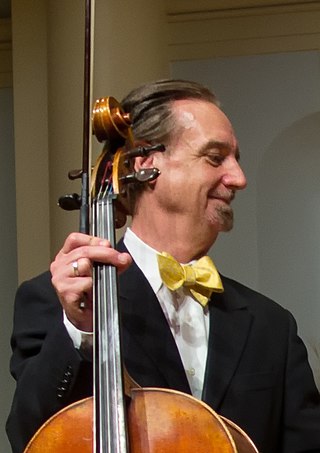
The Classical Period was an era of classical music between roughly 1750 and 1820.

The term string quartet refers to either a type of musical composition or a group of four people who play them. Many composers from the mid-18th century onwards wrote string quartets. The associated musical ensemble consists of two violinists, a violist, and a cellist. The double bass is almost never used in the ensemble mainly because it would sound too loud and heavy.

Chamber music is a form of classical music that is composed for a small group of instruments—traditionally a group that could fit in a palace chamber or a large room. Most broadly, it includes any art music that is performed by a small number of performers, with one performer to a part. However, by convention, it usually does not include solo instrument performances.
Sonata form is a musical structure generally consisting of three main sections: an exposition, a development, and a recapitulation. It has been used widely since the middle of the 18th century.
Robert Wilfred Levick Simpson was an English composer, as well as a long-serving BBC producer and broadcaster.

Sir Donald Francis Tovey was a British musical analyst, musicologist, writer on music, composer, conductor and pianist. He had been best known for his Essays in Musical Analysis and his editions of works by Bach and Beethoven, but since the 1990s his compositions have been recorded and performed with increasing frequency. The recordings have mostly been well received by reviewers.
In music, variation is a formal technique where material is repeated in an altered form. The changes may involve melody, rhythm, harmony, counterpoint, timbre, orchestration or any combination of these.

The String Quartet No. 14 in C♯ minor, Op. 131, was completed by Ludwig van Beethoven in 1826. It is the last-composed of a trio of string quartets, written in the order Opp. 132, 130, 131.
Cyclic form is a technique of musical construction, involving multiple sections or movements, in which a theme, melody, or thematic material occurs in more than one movement as a unifying device. Sometimes a theme may occur at the beginning and end ; other times a theme occurs in a different guise in every part.
Sonata form is one of the most influential ideas in the history of Western classical music. Since the establishment of the practice by composers like C.P.E. Bach, Haydn, Mozart, Beethoven, and Schubert and the codification of this practice into teaching and theory, the practice of writing works in sonata form has changed considerably.

Ludwig van Beethoven is one of the most influential figures in the history of classical music. Since his lifetime, when he was "universally accepted as the greatest living composer", Beethoven's music has remained among the most performed, discussed and reviewed in the Western world. Scholarly journals are devoted to analysis of his life and work. He has been the subject of numerous biographies and monographs, and his music was the driving force behind the development of Schenkerian analysis. He is widely considered among the most important composers, and along with Bach and Mozart, his music is the most frequently recorded.

The String Quartet No. 8 in E minor, Op. 59, No. 2, was written by Ludwig van Beethoven and published in 1808. This work is the second of three of his "Rasumovsky" cycle of string quartets, and is a product of his "middle" period.

The Grosse Fuge, Op. 133, is a single-movement composition for string quartet by Ludwig van Beethoven. An immense double fugue, it was universally condemned by contemporary music critics. A reviewer writing for the Allgemeine musikalische Zeitung in 1826 described the fugue as "incomprehensible, like Chinese" and "a confusion of Babel". However, critical opinion of the work has risen steadily since the early 20th century and it is now considered among Beethoven's greatest achievements. Igor Stravinsky described it as "an absolutely contemporary piece of music that will be contemporary forever".
D minor is a minor scale based on D, consisting of the pitches D, E, F, G, A, B♭, and C. Its key signature has one flat. Its relative major is F major and its parallel major is D major.
Hans (Heinrich) Keller was an Austrian-born British musician and writer, who made significant contributions to musicology and music criticism, as well as being a commentator on such disparate fields as psychoanalysis and football. In the late 1950s, he invented the method of "wordless functional analysis", in which a musical composition is analysed in musical sound alone, without any words being heard or read. He worked full-time for the BBC between 1959 and 1979.
The String Quartet No. 2 in A minor, Op. 13, was composed by Felix Mendelssohn in 1827. Written when he was 18 years old, it was, despite its official number, Mendelssohn's first mature string quartet. One of Mendelssohn's most passionate works, the A minor Quartet is one of the earliest and most significant examples of cyclic form in music.
Homotonal (same-tonality) is a technical musical term that describes the tonal structure of multi-movement compositions. It was introduced into musicology by Hans Keller. According to Keller's definition and usage, a multi-movement composition is 'homotonal' if all of its movements have the same tonic (keynote).

David Finckel is an American cellist and influential figure in the classical music world. The cellist for the Emerson String Quartet from 1979 to 2013, Finckel is currently the co-artistic director of the Chamber Music Society of Lincoln Center in New York, co-founder of the independent record label ArtistLed, co-artistic director and co-founder of Music@Menlo in Silicon Valley, producer of Cello Talks, professor of cello at The Juilliard School, and visiting professor of music at Stony Brook University.
Johannes Brahms' String Quartet No. 1 in C minor and String Quartet No. 2 in A minor were completed in Tutzing, Bavaria, during the summer of 1873, and published together that autumn as Op. 51. They are dedicated to his friend Theodor Billroth. He only published one other string quartet, No. 3 in B-flat Major, in 1876.








